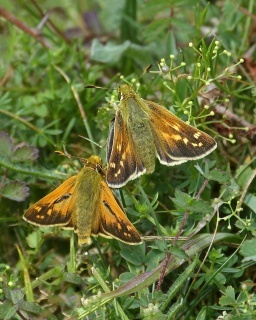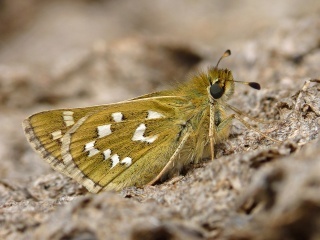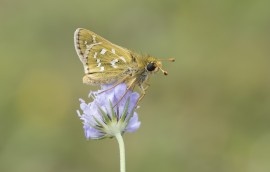by Martin Kalaher
The “golden skippers” are undoubtedly the “little brown jobs” of the butterfly world but they are engaging little insects and with close views they can be every bit as lovely as our larger, more flamboyant species. In Sussex, we have four species, Large Skipper, Small Skipper, Essex Skipper and Silver-spotted Skipper. In the field they can be difficult to tell apart as they are small brown butterflies that fly around at great speed. However, they are not especially skittish and with a slow approach we can often enjoy a close view and be confident of our identification, unless we are faced with the Small Skipper/ Essex Skipper conundrum. With practice these two species can be separated but if in doubt it makes sense to take one or two photographs to scrutinise at leisure. With an image to examine we should be able to ID these skippers, most of the time!
For each species there are eight photographs. In the first row, the first two photos are males and the second two are females. In the second row there is a mixture of both sexes, photographed in a variety of postures.
Large Skipper
With open wings and upperparts fully-exposed, a male Large Skipper is a very distinctive butterfly. The background colour of the front half of the forewing is mostly orange and the rear half is mostly brown. The sex brand is very bold and runs across the veins of the forewing. The ends of the antennae are spatulate in shape and there is a fine hook at the very tip.
The females have very prominent veins and the background colour of the upperparts is a complex mosaic of various hues of brown, orange and yellow. When the eggs have developed the females have large distended abdomens as in pics 3 and 4. With closed wings, both sexes have a cobblestone pattern towards the rear of both forewing and hindwing, which are sometimes optimistically confused with the very distinctive white blocks of Silver-spotted Skippers.
Small Skipper
Male Small Skippers have golden upperparts, with every wing, neatly-edged with brown. The sex brand is dark brown, which contrasts with the very pale golden/orange of the forewing upperparts. It is not lined up with the veins but runs across them, creating the illusion of a tear in the wing. The antennae tips are club-shaped (with a slight lip) and depending on the angle of the light they are either mostly orange, or sometimes a dark brown (when they can be confused with Essex Skippers). You don’t have to see much orange in the antennae tip to be confident that the butterfly in question is a Small Skipper and not an Essex Skipper. When separating these two skipper species is proving difficult, then we should check the underside of the forewing. In both species the background colour is a pale orange, with a variable amount of grey at the apex. Small Skippers have a fairly sharp demarcation from orange to grey, but with Essex Skippers the two colours simply merge together. This is a relatively weak ID feature, but it does show quite well in pic 16, and also pics 14 and 15.
Female Small Skippers share all the characteristics of the males but without the sex brand. They are a little bit darker with a background colour closer to orange than gold. They have darker veins and a brown edging that is a little wider and less well-defined, compared to the males.
Essex Skipper
Essex Skippers are much darker compared to Small Skippers. This is probably not that obvious “in the field” but when looking at photographs it is apparent that the background to the upperparts is a dark orange, not a golden-orange. The veins are darker, as is the brown edging to the wings. In contrast to Small Skippers the sex brand of male Essex Skippers is generally not easy to see. It is short and straight and runs parallel with the veins of the forewing, not against the grain. We are lucky to have a good view (as in pic 17) but more usually we have to look carefully before we spot the sex brand (as in pic 18) and often we cannot see it at all, as it merges with the veins of the forewing. Otherwise, we need to look at the antennae tips, which appear as if they have been dipped in black ink. Whilst this is 100% diagnostic for Essex Skippers, we need to have a clear view from below or to the side, as in pics 21, 22 and 23. Taking the right antenna tip of pic 22 as an example, if we look at the outer third of the antenna we can see a sharp demarcation between the orange and black, and the tip itself is completely black. If we continue to look at pic 22, we can scrutinise the underparts of the forewing which show well. The background colour is mostly orange but as we look towards the apex there is a gentle merging of colours to a grey/brown. There is no sharp demarcation of orange to grey, as seen in Small Skippers.
Female Essex Skippers are darker than the males, as seen in pics 19, 20 and 24. Sexing Essex Skippers can sometimes be straightforward, provided the abdomen shows well, as in pics 19 and 20. We can be very confident that pics 19 and 20 are females as they have very plump abdomens that taper to a point (the males have flat abdomens, with square tips). The whole of the antennae of female Essex Skippers are much darker compared to the males, which means that there isn’t the same obvious contrast between the black tips and the main stem. Looking at the left antennae tip of pic 24 there is the same “dipped ink” to the tip but as the whole of the antennae stem is dark, it is nothing like as obvious as in some of the male images.
Silver-spotted Skipper
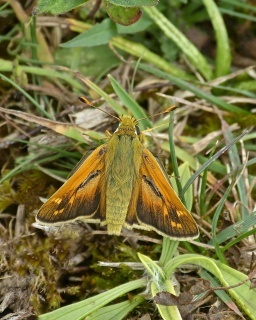 Pic 25. Male Silver-spotted Skipper
Pic 25. Male Silver-spotted Skipper
,-cissbury-ring-31.7.19-9908817415-1094165262.jpg) Pic 26. Male Silver-spotted Skipper
Pic 26. Male Silver-spotted Skipper
The following text has been copied from The Butterflies of Sussex: “The upper surface of the Silver-spotted Skipper’s triangular wings is a mix of burnt orange and chocolate-brown, studded with small patches of pale yellow. As with all “golden skippers”, the male is easy to distinguish by the prominent, black “sex-brands” which run across its forewings. The similar size, ornament and colour palette can sometimes lead to confusion with the Large Skipper. However, the tones of the Silver-spotted are richer and the design shows greater contrast. The real giveaway is the patterning on the underside of particularly the hindwings. Although the Large Skipper has paler, blocky patches of golden-yellow here, the Silver-spotted has much more clearly defined, rectangular markings, which meet the olive-green ground-colour with sharp contacts”.
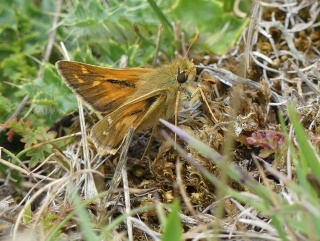 Pic 29. Male Silver-spotted Skipper
Pic 29. Male Silver-spotted Skipper
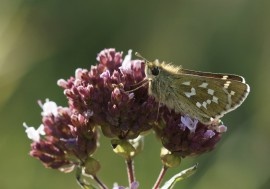 Pic 30. Silver-spotted Skipper
Pic 30. Silver-spotted Skipper
With possible confusion species it is always worthwhile giving some thought as to where we are likely to see these butterflies and at what time of the year. Silver-spotted Skippers are only found on open-aspect downland meadows, and where the turf is kept short by grazing animals. We see them basking in the sunshine in a rabbit scrape, or nectaring on short-stemmed downland flora. This is not the type of habitat where we would generally expect to see Large Skippers. As for their flight periods, there is an overlap in the second half of July and early August but during that time most Large Skippers are likely to be rather worn and the blocky patches of golden-yellow not very easy to see.
Picture Credits: Jonathan Crawford (29), Katrina Watson (30), Bob Eade (32), John Williams (25,28), Neil Hulme (26,27,31), Vince Massimo (8) all others by Martin Kalaher.



-887264576.jpg)
-5309485499.jpg)
-1305208285.jpg)
-185791277.jpg)
-1407818179.jpg)
-5644956082.jpg)
-1308836308.jpg)
-2417394244.jpg)
-947816595.jpg)
-1618232410.jpg)
-7175905397.jpg)
-8485101070.jpg)
-1053247693.jpg)
-8756702910.jpg)
-4930546912.jpg)
-9579259911.jpg)
-8935518283.jpg)
-7650427008.jpg)
-6575980698.jpg)
-1617159573.jpg)
-4900032412.jpg)
-7918882090.jpg)
-9266312238.jpg)
-6224238169.jpg)
,-cissbury-ring-31.7.19-9429517025-5832894770.jpg)
